
Growing Up Flamingo
New chicks at the Zoo are going through remarkable changes on their way to adulthood
BY Eston Ellis
Photography by Ken Bohn
From an egg about the size of an avocado, a tiny ball of grayish-white fluff emerged—rustling, ravenous, and in need of its parents’ care. But in this case, the long-legged, pink-feathered mom whose wing it was poking its head out from under was not its biological parent.
In July, that baby bird and 11 others hatched by members of the San Diego Zoo’s 110-member American flamingo Phoenicopterus ruber flock were chicks of another species: greater flamingos Phoenicopterus roseus. In a first at the Zoo, American flamingos were selected to serve as “foster parents” to raise a new population of greater flamingo chicks, hatched in their one-foot-high mud nests. The greater flamingo eggs were laid by the Safari Park’s 224-bird flock—which is the largest at any Zoo in the world.
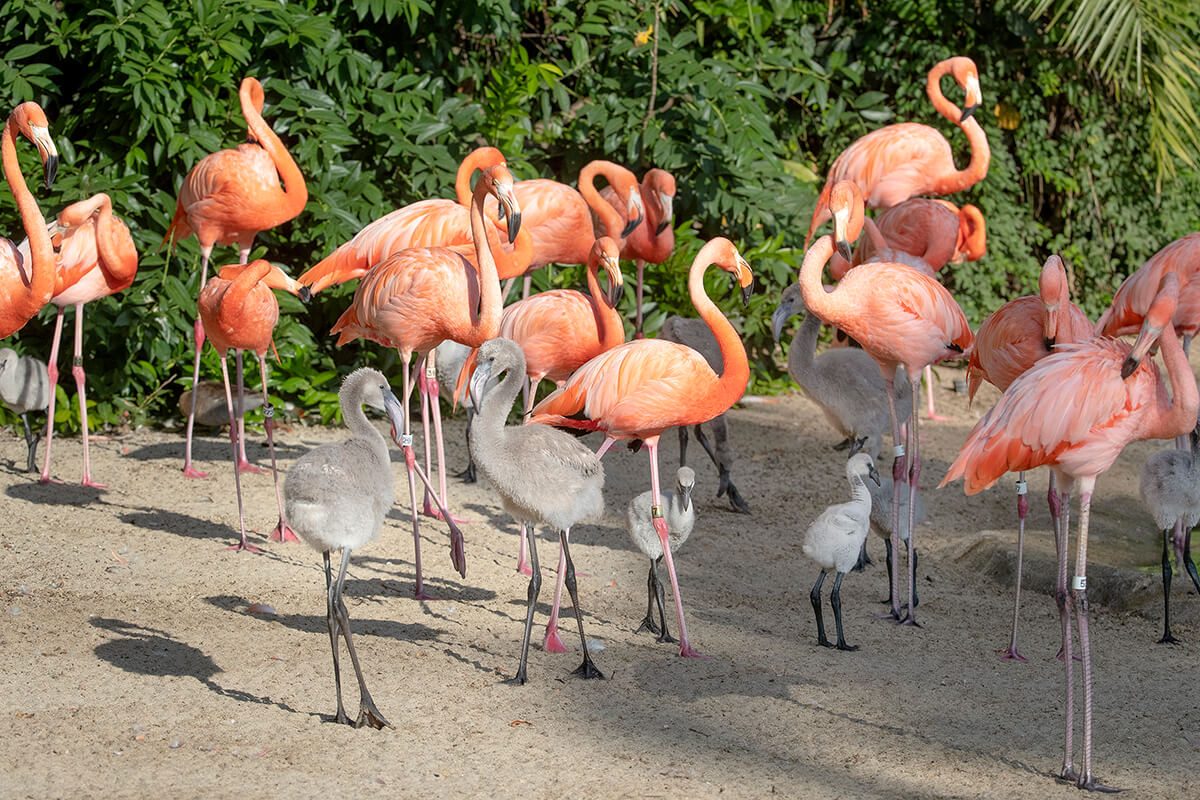
FOR THE GREATER GOOD
Plans are to raise another generation of greater flamingo “foster chicks” in the Zoo’s American flamingo flock next year, creating a total population of juvenile greater flamingos that is large enough to form a flock of their own. The new flock is expected to move to the lower duck pond in 2020.
As foster parents, each of these American flamingo moms and dads is now raising and caring for a youngster that isn’t their biological offspring. However, unlike the typical foster parents, their flamingo youngster will eventually grow up as an entirely different species, and will someday live in a flock of its own.
Because these two flamingo species are very similar, the American flamingos have been able to raise the new chicks as their own and teach them how to be flamingos, in a way that keepers could not duplicate if the chicks were hand-raised. The goal is to support the Association of Zoos and Aquariums Species Survival Plan (SSP) for greater flamingos, creating a healthy assurance population by starting a new flock at the Zoo, which will eventually populate what is now the lower duck pond.
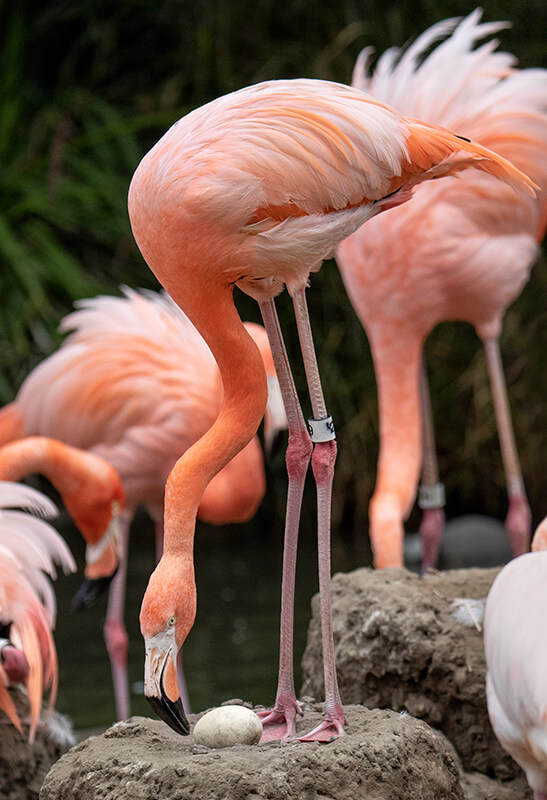
HIGH-RISE NURSERY
Flamingo chicks hatch from an avocado-size egg laid in a nest atop a tall mound of mud. The mounds, about a foot high, are started by keepers and finished by flamingo parents before the egg is laid.
“American flamingos are also an SSP species, and we get recommendations on which birds to breed and which not to breed, as a result of genetics,” explained Dave Rimlinger, curator of birds at the Zoo. “If you only had a few flamingos, you could take the male from one exhibit and the female from another and put them together with no problem. But when you have a large flock like ours, in reality, they can pair with whomever they want—and many times, a recommended bird will pair with an unsuited bird.”
This year, keepers swapped eggs laid by 12 of those not-recommended-for-breeding pairs with greater flamingo eggs from the Safari Park. But the timing for the egg switch had to be just right, Dave said. “They only produce crop milk when it is about time for their chick to hatch. We have to be kind of close with the foster egg. A lot of record keeping and manipulation was required on our part.”
Keepers taking care of the flamingos made detailed maps of the flamingos’ habitats at the Zoo and the Safari Park, labeled where every bird’s nest mound was located, and tracked the progress of each breeding pair and egg in great detail. “We were constantly sending spreadsheets back and forth between the Zoo and Park to get the timing right,” Dave said. “If the keepers didn’t have these detailed maps, we wouldn’t have been able to do it successfully.”
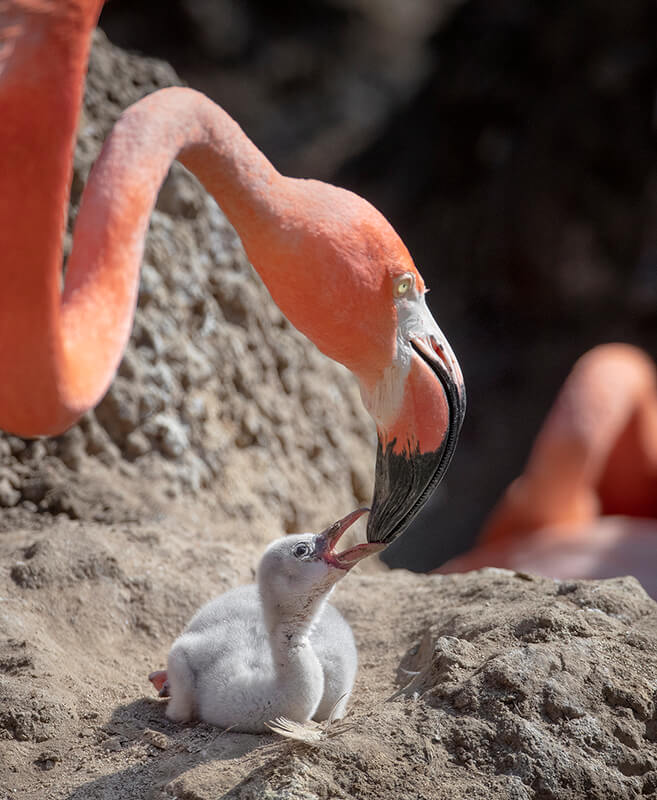
HUNGRY FLUFF
Soon after hatching, flamingo chicks are covered in whitish-gray down, they have straight beaks instead of the characteristic downward-curving beaks of adults, and they are hungry. Parents produce a substance known as crop milk—which they drip from their beak to their chick’s beak—to provide all the nutrients their youngster needs.
Watch Them Grow
As a result of those efforts, and the flamingos’ efforts, guests were able to see the Zoo’s American flamingos parenting their greater flamingo chicks throughout the summer—and they are now watching the many changes these birds are going through as they continue to grow and develop.
One difference Zoo guests may notice between American and greater flamingo chicks is the color of their legs. “Legs of the greater flamingo chicks are black; legs of the American flamingos are pink,” Dave said. “Adult greater flamingos’ legs become very light pink eventually, but the chicks’ legs start out black.”
The color of the greater flamingo chicks’ down is also a little darker than the down of American flamingo chicks. They start out whitish-gray, then become darker gray, before they finally develop their characteristic pink feathers. The adult American flamingo is a dark orange-pink, and is one of the most colorful of the six flamingo species.
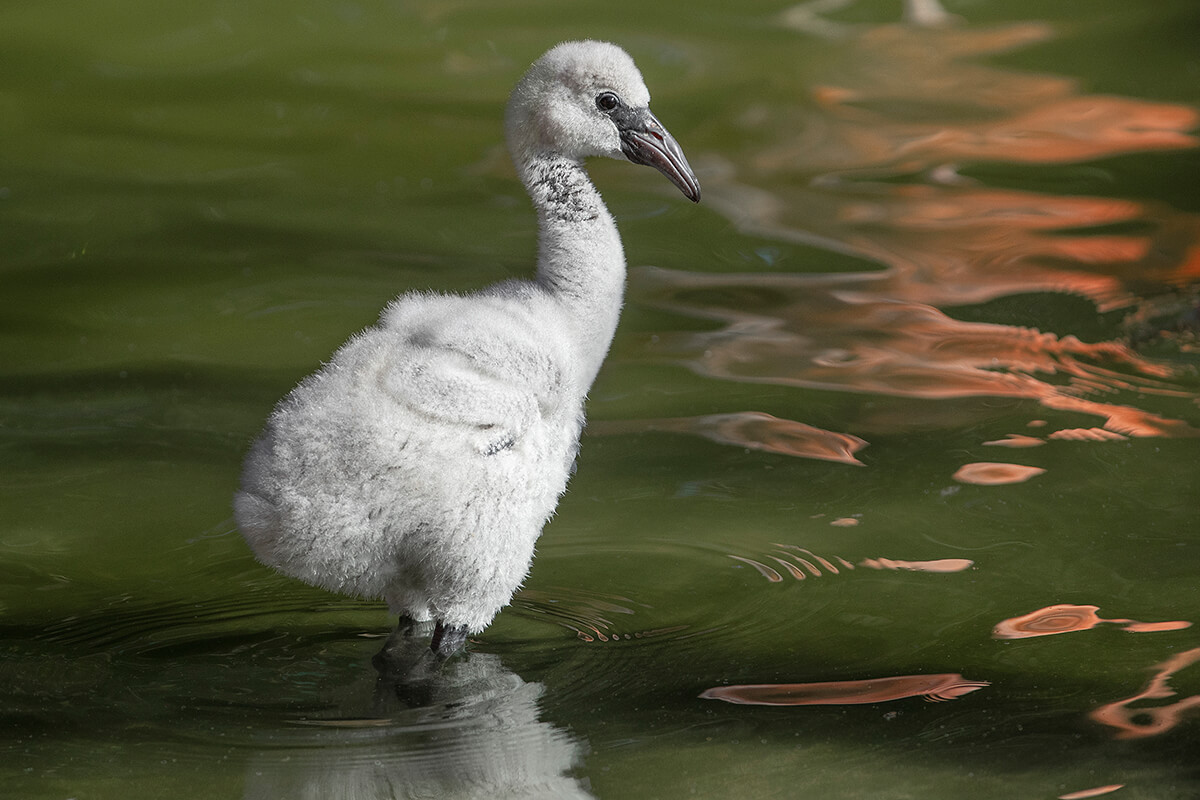
OUT AND ABOUT
Flamingo chicks leave the nest in about five days and start exploring their surroundings—including the water near their nest area. As they get older, they grow rapidly, their down becomes darker gray (and eventually gets replaced with feathers), and their beaks begin to develop a curve.
During breeding season, May through September, adult flamingo pairs build mud mound nests to hold a single egg, and they vigilantly guard those mounds against other birds that might want to nest there. Once the female lays an egg, the parents take turns incubating it for 27 to 31 days. When the egg hatches, the emerging chick stays in the nest for three to five days, occasionally peeking out from under its brooding parent’s wing.
Parents feed their chick by producing crop milk, a substance that sloughs from the parents’ esophagus. Feeding crop milk is an entirely different process from how other birds regurgitate food for their young, Dave explained. “They stand almost motionless, beaks together tip to tip—and if you look very closely, you may see what looks like a trickle going in the chick’s beak.”
“It takes a while—maybe 15 minutes,” said Angie Ray, a lead keeper at the Safari Park, who works with greater flamingos. “Guests who see that sometimes ask us ‘why are those two flamingos’ beaks stuck together?’”
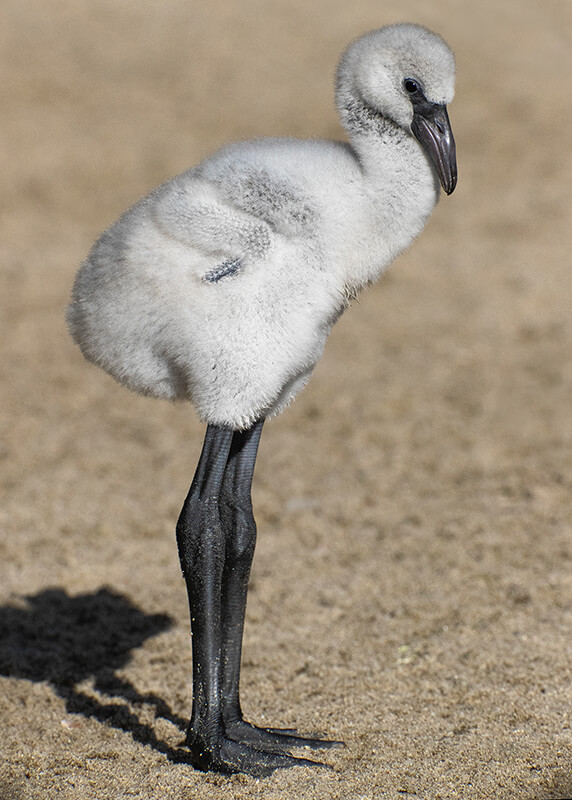
LEGS DON’T LIE
Although the two species are similar, it’s easy to identify the greater flamingo chicks that were raised by American flamingos at the Zoo: they have black legs instead of pink legs.
By day five, the chick is usually ready to begin walking around, and may start swimming, leaving its nest and exploring the rest of its habitat. “Usually, once they get off the mound, they stay off the mound,” Dave said.
During the first two weeks of a greater flamingo’s life, its bill is straight instead of having the characteristic downward curve of an adult flamingo. The bill soon begins to develop its adult shape, though, along with the capability to filter feed—straining food, such as tiny crustaceans, out of a beak full of water. The filtering processes is often accompanied by a unique buzzing sound that sounds something like a boat motor.
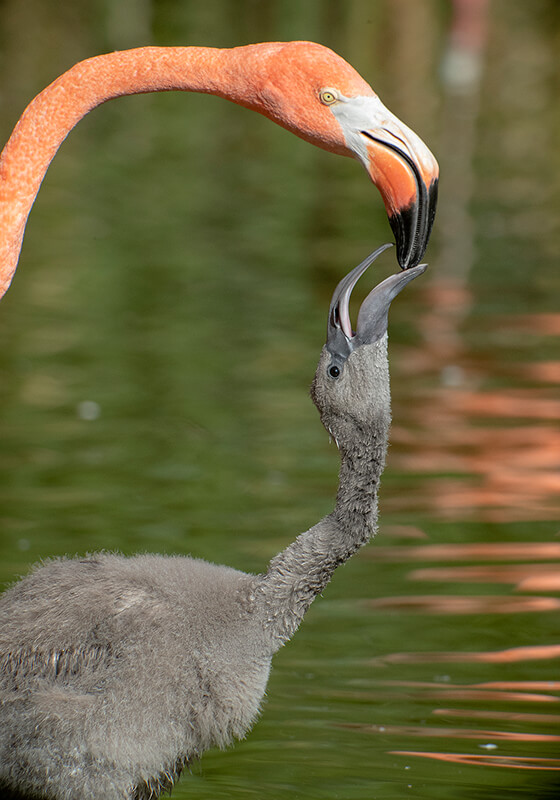
SUPPORTIVE PARENTS
Flamingo parents continue to feed their chicks—sometimes for a year or more—after they leave the nest. Although older chicks gather in a large group called a crèche, watched over by non-parents, each chick’s parents can identify its own youngster by its call at feeding time.
While young chicks may start dabbling as they explore the water’s edge, they still get most of their nutrients from their parents’ crop milk. “Both parents feed the chicks, and they may continue to do so for over a year,” Angie said.
Although feedings continue, the parents don’t continue to provide round-the-clock care when the chick leaves the nest. At that stage, all the chicks from the flock will gather in a crèche, a large group cared for by several non-parent adult guardians. “It’s like day care for flamingos,” Angie explained. When it’s time for a meal, each parent can find and identify its own chick by its distinct call—even in large crèches, where there may be hundreds of chicks.
At about one month of age, each chick’s soft, gray down begins to give way to feathers. “When they hatch, they’re just little guys you could hold in your hand—but at 30 days of age, they stand about 2 feet high,” Dave said. “They grow really fast.” While they may reach full adult size at three to six months of age, it takes three to six years for them to reach sexual maturity. They gradually turn pink over the first two to three years.
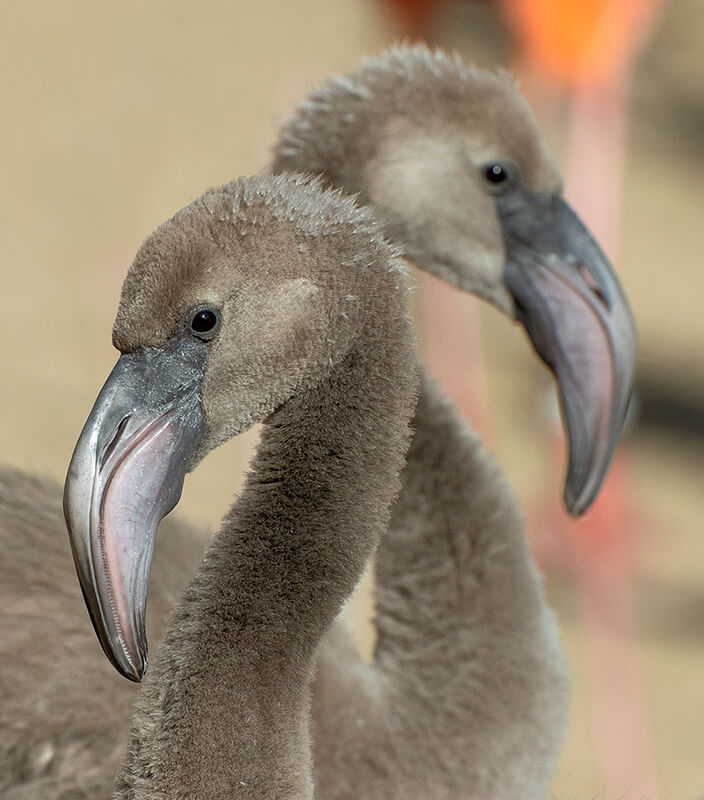
THEIR BEAKS MEAN BUSINESS
At three months of age, juvenile greater flamingos do not yet have their characteristic pink color. However, their beaks have developed the same efficient scoop shape and filter feeding capability of adult flamingo beaks.
Living It Up
“It surprises many people how long a flamingo can live,” Dave said. “In the wild, the oldest observed bird lived 33 years—but in zoos, they can live much longer. Our oldest American flamingos at the San Diego Zoo are 65 and 63 years old, and both of those birds came from the wild as adults. The next oldest is 60, hatched here at the Zoo in 1958; and the next oldest is 56. We have 22 birds that are over 30—and we have had birds in their 50s produce chicks.”
Guests can see flamingos in two locations at the Zoo: in the flamingo lagoon on Front Street, and in Urban Jungle, where a smaller flock of American flamingos serve as animal ambassadors. Guests can hand feed them from cups of water—and witness their efficient (and noisy) filter feeding behaviors firsthand—at the Animals in Action experience. At the Safari Park, guests can see the world’s largest Zoo flock of greater flamingos at African Outpost as well as a flock of 126 lesser flamingos Phoeniconaias minor. Safari Base Camp is home to 53 Chilean flamingos Phoenicopterus chilensis.
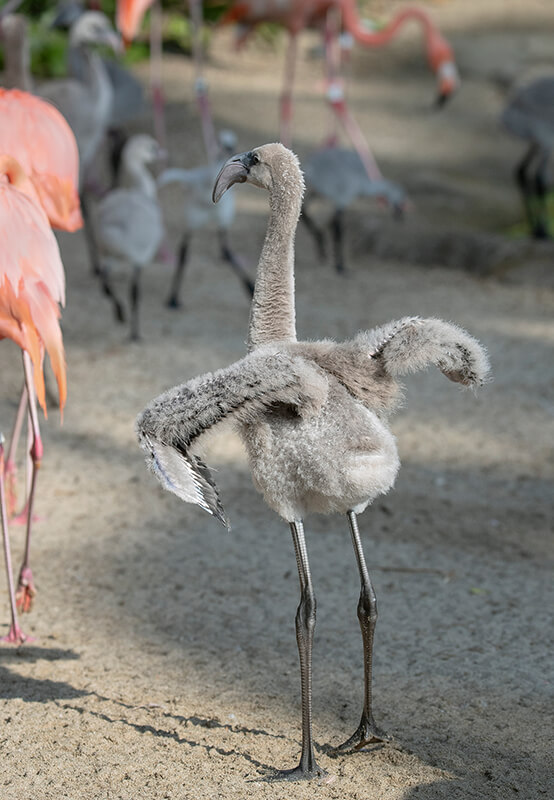
SPREADING THEIR WINGS
Juvenile flamingos grow rapidly, becoming almost as large as adults at just three to six months of age. They gradually turn pink in their first two to three years, but it can take three to six years for the birds to reach sexual maturity.
“People love seeing them nest,” Dave said. “Even people who haven’t see this behavior before get it, when they look at them on the island. They see each flamingo sitting on those mud mounds, then people realize they are nests—and then they see a downy chick poking its head out from under the adult’s wing. The average person can learn a lot by watching the everyday changes that are part of life in the flock.”




